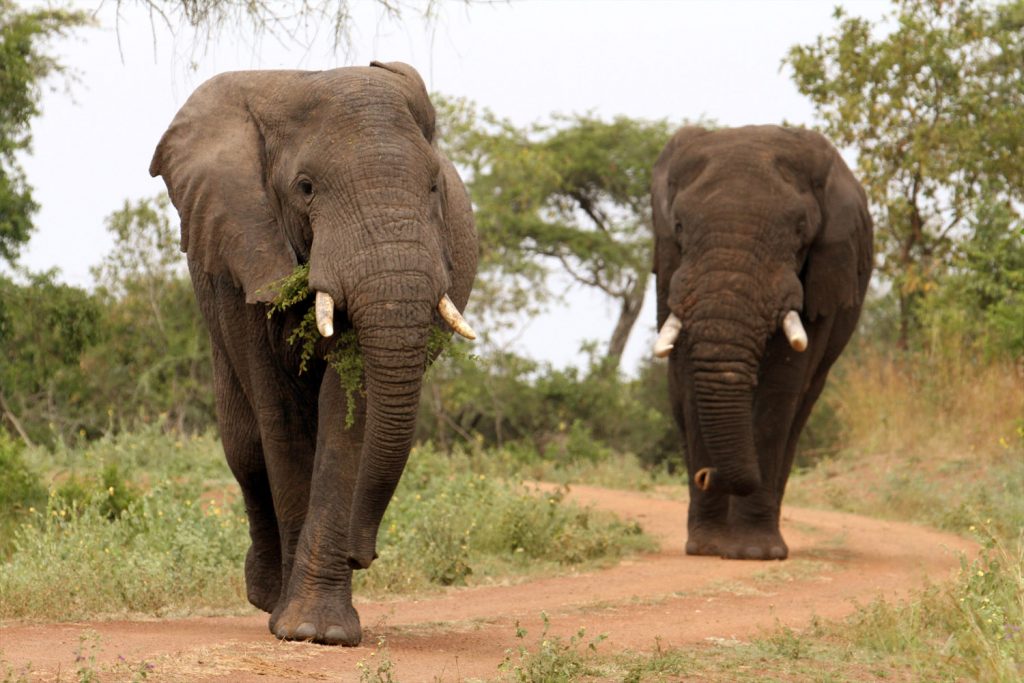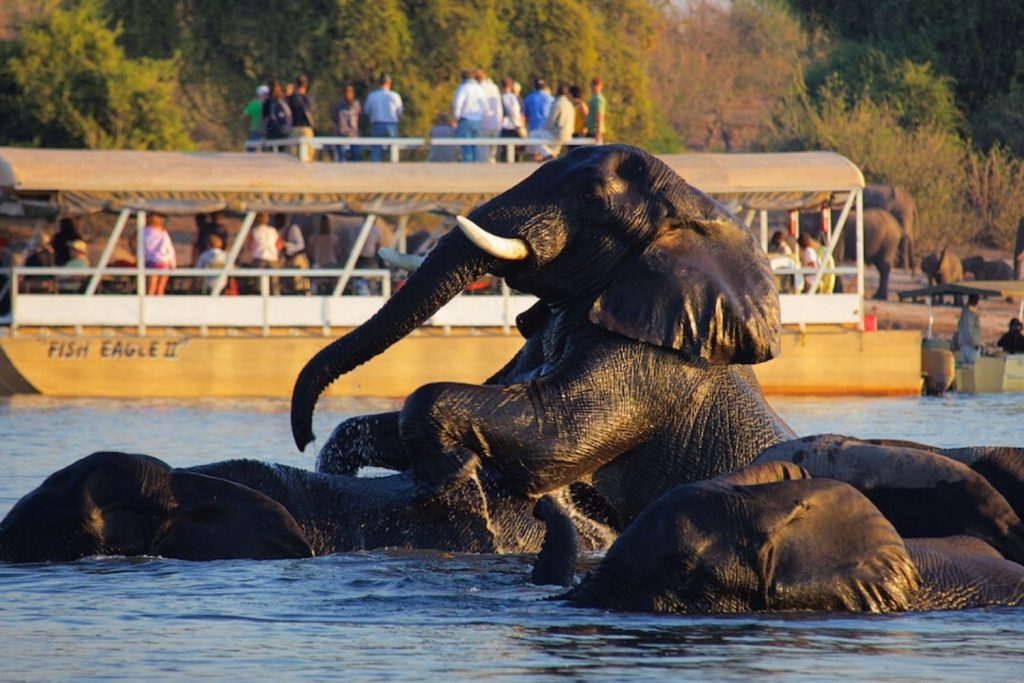Some guidelines on wow to observe elephants in a safe and ethical way on safari in Africa
Elephants are considered some of the most intelligent and emotional animals in the world, not to mention the largest mammal on land. As one of Africa’s big five, tourists readily seek out these gentle giants to view them in their natural habitat. But, like humans, elephants enjoy their personal space, which they prefer not to have invaded. Respecting an elephant’s territory will usually lead to a positive interaction, but aggravating an elephant or getting too close can be very dangerous indeed.
If your overlanding itinerary includes a trip to a Big Five zone, we recommend reading our list of safe elephant viewing guidelines. Not only will these tips keep you safe, but they will make sure that you experience an enjoyable, memorable encounter with one of Africa’s most loved animal species.

How to approach elephants
(keeping you safe and making the experience enjoyable)
Always
- Slow down as soon as you see elephants. Try not to rush up to them.
- Turn off the engine, and sit quietly while you observe the elephants.
- The recommended elephant viewing distance differs between sources, but we recommend giving yourself at least 100-80m to first assess the temperament of the herd. If you are more confident, you can move to a space of about 60-50m away from the elephant. From this point, you can allow the elephants to come nearer to you, which they will do if they feel comfortable.
- Make sure you can easily drive away from the sighting if need be. I.e. assess your exit points before settling down at the sighting
- Keep an eye out for elephants that might approach from the rear end of the vehicle
- Always give the elephants right of way. There should be more than enough space for them to move off the road.
- Retreat slowly if the elephants show signs of unease.
- We recommend giving an elephant bull in musth a lot more space than usual (minimum 100m) as their heightened testosterone levels can make them short tempered.
- Try and avoid bulls in musth where possible. Rather reverse and find an alternative route than drive past a musth bull.
- Be patient with elephants and respect their space.
- Use your common sense and be mindful of the elephants that you are viewing.
Never
- Never park your car over any elephant footpaths that lead off from the road
- Never box in an elephant when other vehicles are present.
- Never cut off or block elephants from the direction that they are walking.
- Never drive or park between members of the elephant herd.
- Never drive for extended periods behind elephants that are walking along the road.
- Never rev the engine when elephants are around.
- Never try to actively push elephants off the road.
- Never speed past elephants or drive faster than what the elephant walks.
- Never drive off the road or leave your vehicle to try and get closer to the elephant.
- Never make any noises or fast, jerky movements to attract their attention.
- Never yell or shout when near an elephant.
- Never hang out the window or sunroof.

How to tell if an elephant is relaxed
More often than not, elephants will have grown accustomed to human presence, particularly in places like the Kruger Park or Addo Elephant Park where they receive regular visits from tourists. When they are comfortable in the presence of humans, they will typically go about their daily activities and ignore your vehicle.
You will be able to tell if an elephant is relaxed if:
- Its eyes are cast down in a relaxed, lazy manner
- The back legs are crossed, and they are leaning on one leg
- The elephant is paying attention to the vegetation its feeding on, giving very little attention to the viewer
- The elephant is feeding with its back to the viewer, usually with its head below the line of the shoulder
- The tail is swished from side to side in a relaxed manner

How to tell if an elephant is uneasy or uncomfortable
Elephants will use their body language to communicate if they are feeling uncomfortable or uneasy in your presence. These postures, stances and gestures are considered signs of apprehension, and indicate that an elephant is either assessing whether you’re a threat or not. In these instances, be sure to have the vehicle turned off at a considerable distance away from the elephant. Be as quiet as possible and make sure you give the elephant plenty of space.
- Chin slightly up and ears slightly spread
- Plucking at vegetation without actually eating anything
- Front foot raised and swinging tentatively
- Touching own face with trunk
- Twisting the tip of the trunk back and forth
- Raising/stiffening of the tail
Elephants will also make use of body language to indicate that you have aggravated or annoyed them. If the display any of these gestures, be sure to retreat slowly away from the sighting.
- Ears spread at 90 degrees from the body and facing the opponent. You can consider this a very serious threat if the tusks are pointed towards you as well. (Do not confuse this with ear flapping, which relaxed elephants do as a means of cooling down.)
- Head lifted high to look taller, with chin raised to ‘look down’ at the adversary.
- Trumpeting
- Swinging the trunk forward towards the opponent
- Throwing dust, branches or objects directly in the direction of the opponent. Try not confuse this with relaxed elephants who will typically throw dust onto themselves
- Tossing the head and tusks through vegetation to demonstrate their strength
- Tusking the ground is a very common and serious sign of aggression. In this case, elephants will bend or kneel down and push their tusks into the ground.
The difference between a mock charge and a real charge
Mock charge
Elephants don’t always necessary charge with the intention of connecting with the opponent. In some instances, they will give a warning charge to indicate that they are unhappy. In these scenarios, the elephant will rush towards the vehicle and then stop abruptly in a tall position with their ears spread. They will also possibly kick dust using one of their front feet or swing their trunk towards the vehicle. A mock charge is also typically accompanied by trumpeting.
We advise that you take mock charges seriously as they could transition into a real charge if the elephant continues to feel threatened or aggravated. Do not rush away from the sighting, but rather retreat cautiously until you are a considerable distance away from the elephant.
Real charge
The biggest difference in body language between a real and mock charge is the placement of the ears. If an elephant is charging you for real, they will have their ears placed against their body when rushing towards the vehicle. The trunk will be tightly curled up (so that it is out the way), the head will be held down low and the tusks will be pointing towards the vehicle. A real charge is fast and silent, so be sure to pay attention to early warnings before the elephant feels the need to charge.
How to tell if an elephant bull is in musth
The word ‘musth’ is derived from the Sanskrit word for intoxicated, and is used to describe when healthy bull elephants experience a heightened state of reproductive hormones. Once an adult bull reaches adulthood, they will experience this phenomenon annually.
You can usually tell that a bull is in musth if they are heavily secreting an oily substance from their temporal glands (sides of their heads), and if they have a steady trickle of urine running down their hind legs. Elephants are typically more energetic, aggressive and unpredictable when in musth due to an increase in testosterone levels. It’s best to try and avoid elephants in musth where possible.
How to handle dangerous elephant encounters
While you might follow all of our recommended guidelines, it is not always possible to avoid a negative encounter with an elephant. While each situation may be unique, we recommend the following guidelines when you find yourself in a threatening situation:
- If an elephant approaches your vehicle and you are unable to leave the area, it is important to remain calm. Focus on breathing deeply and try not to make any sudden movements. Wait until the elephant has moved off before trying to leave the sighting.
- Stand your ground when an elephant mock charges you. Once the elephant has stopped, wait a while before moving away. Reversing or driving away from the elephant too early on could prompt the elephant to charge and chase your vehicle.
- In very severe cases, such as where an elephant is charging you, you can try and tap the side of your vehicle door and raising your voice in an assertive tone (be careful not to shout, but rather raise your voice sternly). Remain calm as any aggressive tones may aggravate the elephant. Once the elephant has been distracted, use the opportunity to leave the sighting.
What to do if elephants approach your campsite
In many big-game areas in Southern Africa, the campsites are unfenced. This means that wild animals can visit your posse any time, including elephants. While this can be a wonderfully exciting experience, having such a large animal at close quarters can cause the heart rate to falter.
- If an elephant approaches your campsite, remain stationary. Do not approach the elephant or try and chase it away.
- If you feel uncomfortable or threatened by an approaching elephant, move slowly towards your vehicle and quietly get inside.
- Do not, under any circumstances, try to feed the elephant.
- It’s best not to take any fresh fruit to a campsite where elephants are known to be regular visitors. However, if you do find yourself with a bag of juicy treats, make sure to store them in an air-tight container, or inside your vehicle.
- Stow away all your garbage in your vehicle at night.
Remember these five elephant viewing credos
1. Respect the elephant and use your common sense
2. Be a courteous guest and remember that you are in the elephant’s territory
3. Always give the elephant right of way
4. Elephant appreciate silence, patience and slow movements
5. Do not bombard an elephant’s personal space
Self drive through Africa
Ready to spot some elephants? Contact us for a tailor made self drive safari to Africa. Or check out some sample routes.
Source: Bushlore
